What To Make Of A Diminishing Lake?
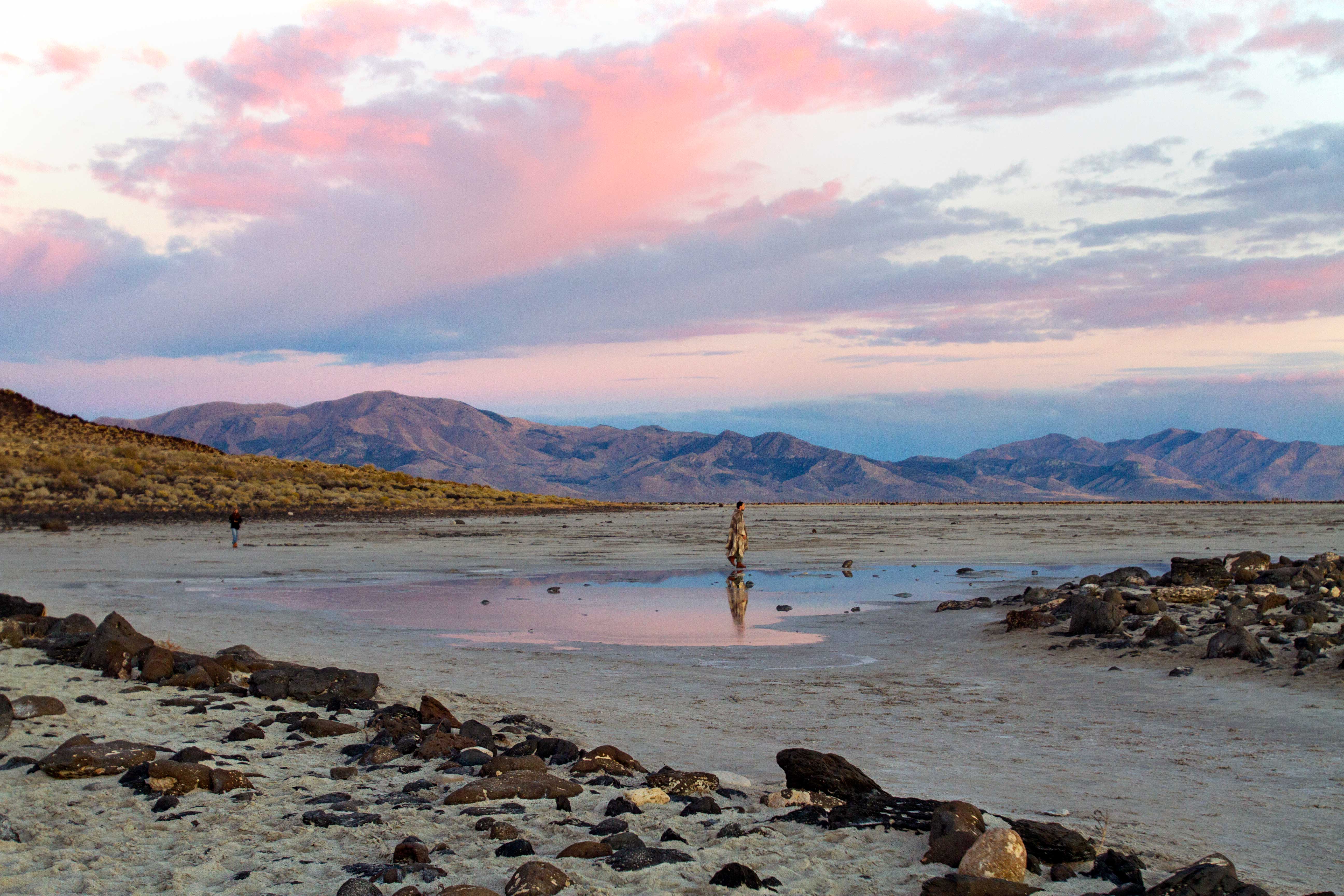
It is a blue speck from space that helps you find your place on Google Maps.
It flashes like a beacon to millions of birds on migratory marathons. It is a sea in the sand that shimmers lavender in one glance and pale turquoise in another. A place you can go for an entire day without seeing a single soul, yet where two million people live within an hour’s drive. It is a lake of paradoxes, said historian Dale Morgan, a liquid lie, said author Terry Tempest Williams. The salty truth, however, is that the Great Salt Lake, the largest saline lake in the Western Hemisphere, is drying up.
In late August, heavy smoke from regional fires added to its mystique as 18 Utah State University graduate students in watershed sciences hiked along the backbone of Great Salt Lake’s Antelope Island. They were there to listen to Wayne Wurtsbaugh share some of the unknowns he’s uncovered over the past 35 years of research and teaching.
In 2017, Wurtsbaugh and colleagues published a paper in Nature Geoscience that chronicles the decline of saline lakes around the world. Although his status in the USU Quinney College of Natural Resources Watershed Sciences Department is professor emeritus, retirement has not slowed Wurtsbaugh. He has accumulated enough data to write papers over the next decade. Wearing a wide-brim hat with the chinstrap tightly cinched, charts and graphs in hand, he tells the students about the lake that glistened around them. With a panoramic view from their perch among the Archean boulders, Wurtsbaugh describes where the lake has been, where it is today, and what lies ahead.
A mighty remnant
The Great Salt Lake, a remnant of a mightier Lake Bonneville, is around 10,000 years old. But even the current lake is somewhat of a remnant. Wurtsbaugh showed the students a NASA image of the lake dwarfed by a white outline of its previous shoreline. Over the past 15 decades, human development accounts for a total drop of about 11 feet in lake levels today. For a body of water with an average depth of 15 feet, that difference is enormous and explains why nearly 50 percent of the lakebed is now exposed. Proposed water developments on the books could take the lake down another 10 feet.
“The maximum depth is about 35 feet and so we’re talking about essentially drying up vast, vast portions,” he said.
Even worse, nearby Farmington and Bear River bays have dried up 70 to 90 percent. These fresher waters claim the highest number and most variety of invertebrates and bird populations on the lake. Maybe it was the downward slope of the regression lines on his charts, or the way the Wasatch Mountains had vanished in the midst of the orange-tinted air, but things were beginning to look bleak. And he was only getting started.
Lower lake levels mean the formation of land bridges to islands where birds, like pelicans, require total isolation for breeding and nesting. Coyotes, which have already been spotted on Gunnison Island, could severely disrupt one of the largest colonies of American White Pelicans in North America. Bird populations depend upon this oasis in a desert along this Western Flyway. Birds such as the American avocets, mallards, and swans have critical nesting sites jeopardized by the shallow, shrinking bays of Farmington and Bear River.
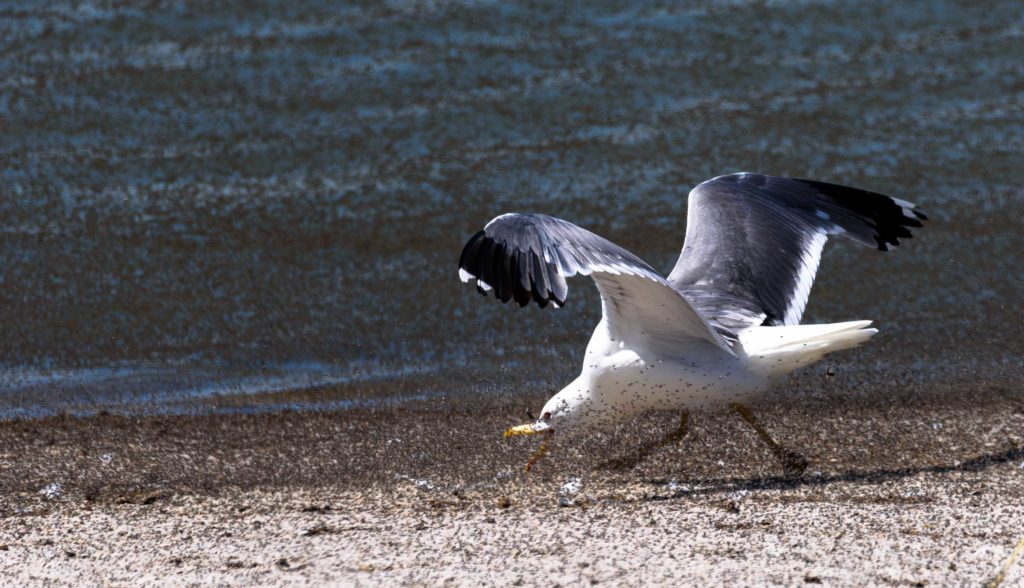
Brine shrimp and flies are only two invertebrates that survive in the Great Salt Lake. They are a veritable feast for hungry birds such as this California Gull. Photo by Wayne Wurtsbaugh.
These fresh-water estuaries provide rich vegetation for dense and diverse fowl populations. As the water level lowers, salinity (already 4.5 times more than seawater) increases in Gilbert Bay, the largest portion of the lake. This means less food for the grebes, shorebirds, and gulls that feed on brine shrimp and brine flies reared in the lake. It might mean dry lakebeds that could increase the potential for locally severe dust storms. Lakebeds that have accumulated all kinds of nasty minerals poured into its waters for decades such as selenium and mercury. Dust not intended for healthy lungs and life.
And even if the lake doesn’t entirely dry up, what is there to be done with the shallower waters in Farmington Bay that create ideal conditions for blooming toxic algae? What if the water’s salinity rises beyond the 8 to 12 percent that brine shrimp require, jeopardizing the state’s $57 million commercial brine shrimp industry? And what is to become of recreation on the lake? Wurtsbaugh pointed in the direction of the island’s stranded marina standing in puddle-deep water. As he spoke, the air temperature was pushing 90 degrees. The students were ready to get their feet wet in the nearby Bridger Bay where the water was about a quarter of mile farther from the parking lot and picnic pavilions than in the decade prior.
Even the Great Salt Lake’s sand is confounding. Wurtsbaugh casually told the students as they were trudging toward the shoreline that they were walking on oolitic sand formed around brine shrimp fecal pellets. A clever way of turning waste into filters, for as these pellets sink, they build up particles of calcium and magnesium carbonate that separate the waste from the rest of the water. To appreciate the difference between oolite and other sand, go barefoot. The smoother pill-shaped oolite makes for a silky traverse.
It did not soften the blow of what was coming―brine flies by the millions. Although they don’t bite, they can be overwhelming. Like the brine shrimp, they are impressive salt-resistant organisms that feed off algae in both its larval and adult stages. It is their worm-like brown pupal casings after they hatch that you see washed up along the shores by the billions. A sci-fi scene from another planet. Even the seagulls seemed surreal, standing Zen-like along the shoreline facing west into the wind, feeding upon the flies that swarmed their way. No need to waste energy. Swarms so thick that they completely covered the shoes of students who left them behind as they waded out into the briny waters.
“Why would anyone want to come here?” asked an exasperated dad in a Google review of the beach.
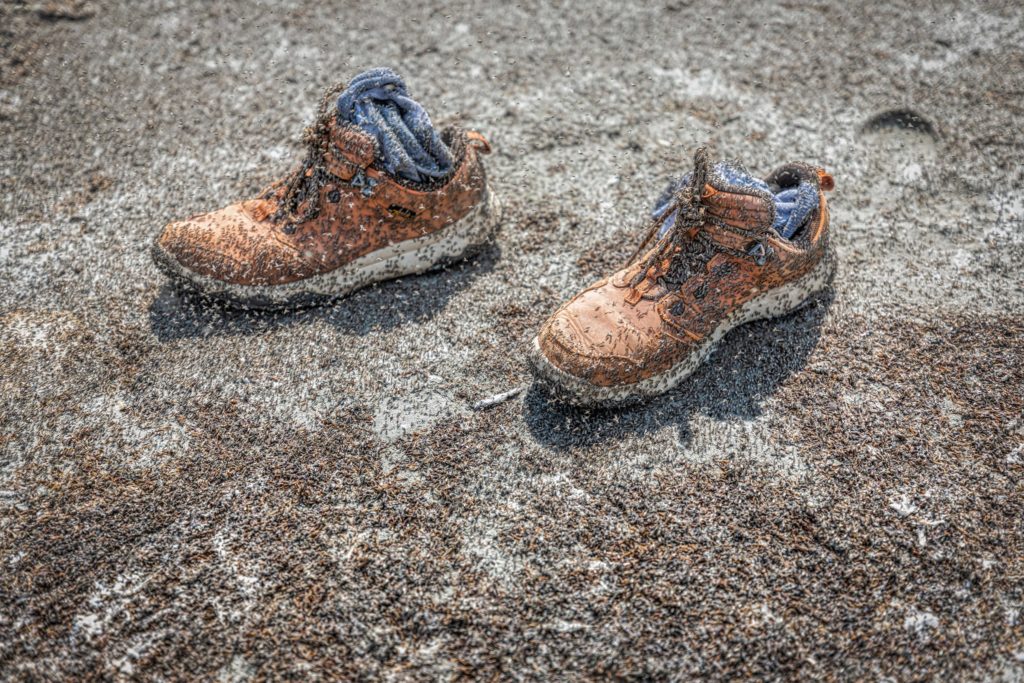
Brine flies and brine shrimp are a critical food supply for migratory birds stopping to feast along the shores of the Great Salt Lake.
For the uninitiated, what feels hostile is really an example of the tremendous complexities of lifeforms that have been able to adapt and flourish in such extreme conditions. But it is a place that you have to meet on its terms, not yours, Mark Larese-Casanova, assistant professor in Watershed Sciences and director of USU Extension’s Utah Master Naturalist program, told students on the walk back to the outdoor showers to rinse their feet.
While swarming flies and larval casings may not be someone’s idea of a day at the beach, Wurtsbaugh explained how important both brine flies and brine shrimp are to migratory birds. What these two invertebrates lack in size, they make up for in sheer number. The brine shrimp and flies are the only two invertebrates that can exist in such salty water. With no fish to compete against, it means a veritable feast for hungry birds. Beginning in September, some 500,000 Eared grebes visit the lake to dine on these distant cousins of the lobster and crab, which help the grebes double their weight during their four-to-six-week stopover, Wurtsbaugh said.
And what is good for the birds bodes well for the lake’s brine shrimp industry, starting in the early 1980s, just about the time Wurtsbaugh arrived at USU. Up to that point, Great Salt Lake brine shrimp were primarily being sold for kids to hatch from “Sea Monkey” packets. That changed around the mid-1980s when the aquaculture tide began to rise worldwide. “The commercial exploitation of the cysts took off, as their use in aquaculture exploded at about that time,” Wurtsbaugh said. It turns out that young prawns and finfish, do really well on baby brine shrimp.
Brine shrimp eggs, or cysts, are durable as aluminum, and float on the surface of the water. They can also completely dry out and still maintain viability. Wurtsbaugh said some have hatched out from sediment extracts more than 200 years old. That makes them ideal for companies to suck up using oil slick booms, dry out, and can for shipping around the world.
Brine shrimp swimming around the lake, at least on the less salty southern side of the Union Pacific Causeway, are good for algae-rich waters in summer. Adult brine shrimp, which measure a half-inch long, are voracious eaters of the stuff. “They are incredibly good grazers,” Wurtsbaugh told the students. “They can graze or clear the water of algae when the population is high, about once a day.” But in the winter, when brine shrimp disappear, the nutrients build and the lake water becomes more eutrophic, or oxygen-deprived.
A problem of our own creation
The students began their five-day field trip at the terminal of the largest contributor to the lake, the Bear River, and would end their journey at its headwaters in the Uinta Mountains of Utah. The lake receives nutrients from the Bear River, as well as the Weber and Jordan rivers. The lake also receives wastewater from treatment plants from Ogden to Salt Lake City, most of it emptying into Farmington Bay. Mostly phosphorus and nitrogen pouring into a bay that on this day had an average depth of 1.5 feet.
“It’s a really shallow bay,” Wurtsbaugh said. “And so you have all those nutrients and lots of light, and the algae and the cyanobacteria are shouting, ‘hallelujah! This is great!’ And so you really have hyper-eutrophic conditions in Farmington Bay … These guys not only produce a lot of chlorophyll and die and decompose and strip the oxygen out of the water, but they also produce cyanotoxins which, gram for gram, are about the same toxicity of Cobra venom. But they don’t have fangs, which is a good thing.”
Not so good is the fact that cyanobacteria reproduces exponentially when conditions are ripe, as they frequently are in Utah Lake. Only one human death in the United States has been linked to it, but several reports of dog and cattle deaths have been, including the death of a dog in Utah Lake a few years ago after swimming in a bloom.
Average toxin levels in Farmington Bay are 40 times higher than in Utah Lake. While Farmington Bay does not support recreation activities, such as water skiing, there is still considerable concern. Removing phosphorus would require hundreds of millions for wastewater treatment plants and the continuing maintenance of additional treatment, Wurtsbaugh said.
And what happens to those cyanotoxins that dry up and blow off a dry lakebed into the Wasatch Front population? One of the graduate students in the group, Austin Bartos, is already grappling with that question. He and his faculty mentor Janice Brahney, USU assistant professor in watershed sciences, are in the early stages of a two and a half-year study looking at the whole pathway of dust from lake basin to the mountains. They are teaming with members of USU’s chemistry and biochemistry department, with an eye on organic pollutants, such as pesticides. They want to know how dust particulates change in composition as they move through the air, and if there are implications to human health.
They are important questions because this lake, unlike other saline lakes, is in close proximity to an enormous population. Dust mitigation would almost certainly be needed, and at a steep price. Los Angeles will spend $3.6 billion over 25 years to reduce airborne particulates from Owens Lake―dust pollution that effects a relatively small 40,000 population living 200 miles away from the city itself. All because in 1913 Los Angeles began diverting the Owens River to quench its growing and thirsty population. By 1926, it nearly drained the lake dry.
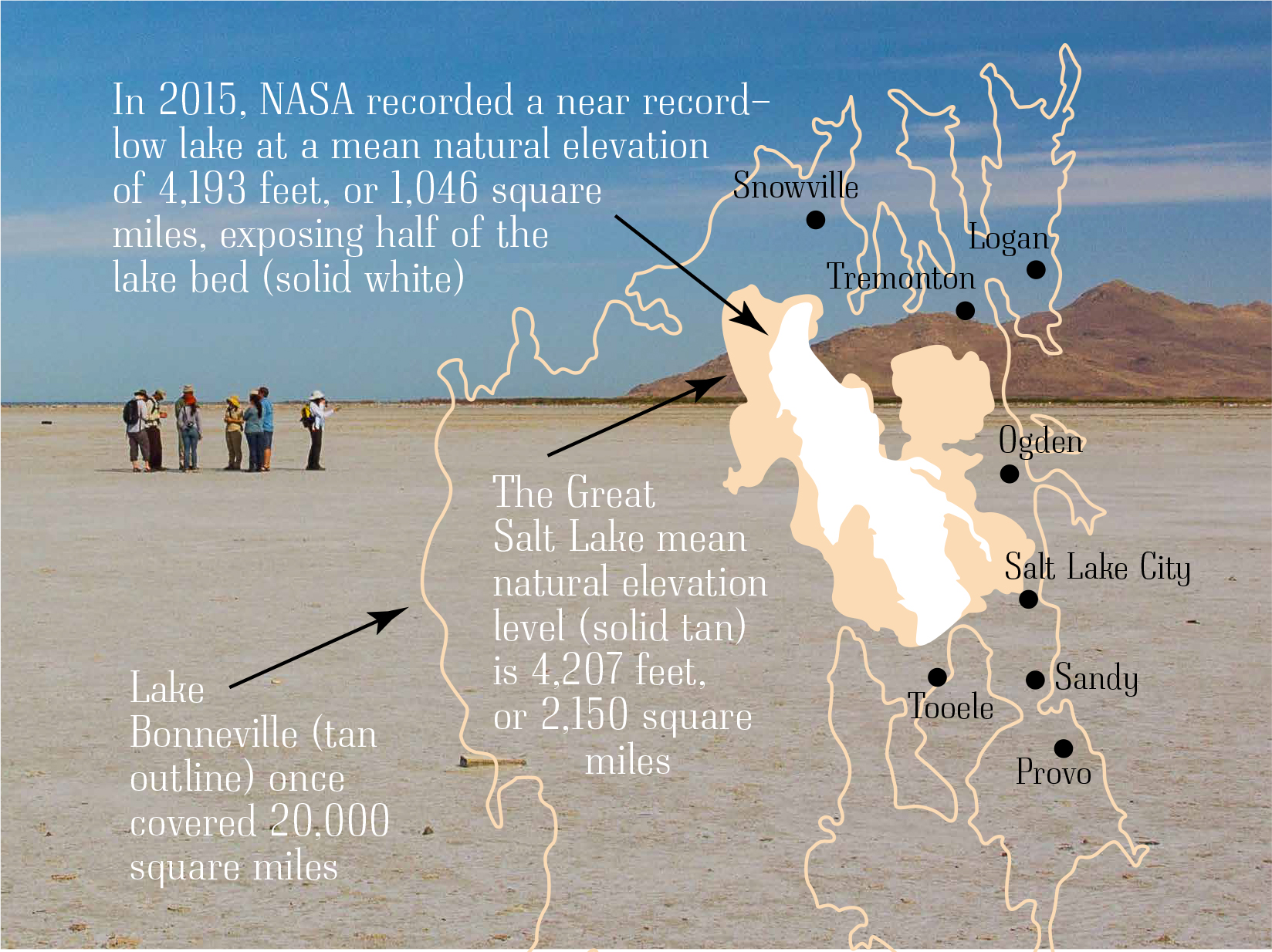
The Great Salt Lake is what remains today of the mighty Lake Bonneville. Its footprint continues to shrink, with nearly 50 percent of the lakebed now exposed since the mid-1800s. Photo by Wayne Wurtsbaugh. Map by Elizabeth Lord.
Sarah Null, associate professor in Watershed Sciences, who recently co-authored a study published in Science of The Total Environment, looks at the cost of addressing saline lake declines by taking an innovative market approach. To get the lake back to its natural level, researchers constructed cost estimates showing that inflows from the Bear, Weber and Jordan rivers would need to increase by 20 percent at a cost up to $96 million. This could be achieved through uniform water right cutbacks, similar to cap-and-trade systems, which would allow intra- and inter-basin trading. The question is whether the state is willing to spend millions now to ensure that water remains in the lake or spend billions later in dust mitigation.
Studies have found a correlation between airborne mineral dust with increased hospital visits for respiratory and cardiovascular diseases, and rates of death. Another showed that dust exposure not only increases the prevalence of asthma and lung infection, it inhibits immune response, and results in cellular and DNA damage. Additionally, the bacteria and microorganisms that dust can transport also poses a threat to the health of humans and the ecosystem.
Brahney’s research might help allay fears. Maybe they will find that the particulate matter formed from the Great Salt Lake’s exposed lakebeds is relatively harmless to nearby residents. But if it is not, she said, and dust storms continue to blow toxins from the sediments that don’t degrade, into the faces of two million people, isn’t that something residents and lawmakers would want to know?
The same funding source for Brahney’s research project, the Utah Department of Natural Resources, Division of Forestry, Fire and State Lands, has funded 16 other USU projects connected to the Great Salt Lake over the past decade on research ranging from habitat quality to wetland re-vegetation. Research that creates data to help private and state agencies make informed decisions in planning for the lake’s future. Currently, at least 11 USU research projects connected to the lake are underway.
For example, USU’s Joanna Endter-Wada, professor of environment and society, is wrestling with how to adapt local water needs during drought through informal rules and agreements that are fair to all. The executive director of FRIENDS of Great Salt Lake, Lynn de Freitas, says university research is the bedrock in guiding what must be done on behalf of the entire lake system.
“USU is, by example, a community institution that looks to engage, that looks to help effect understanding, and recognizes what science, community relationships, and community work can achieve,” she said. “USU has been there on many different fronts and in many different capacities.”
Those fronts not only include field and lab time, but countless hours on state boards and commissions by faculty members whose reports land directly on the governor’s desk. One paper was a 100-page document compiled by the Governor’s Water Strategy Advisory Team, which Endter-Wada hopes will elevate concerns over the flow amount and quality of water going into the Great Salt Lake. The document includes a lengthy summary of public listening sessions. While most people viewed water as an important ecological asset and that natural waters need first priority, others disagreed, saying that communities are better off by using up all of the water before it can reach the lake.
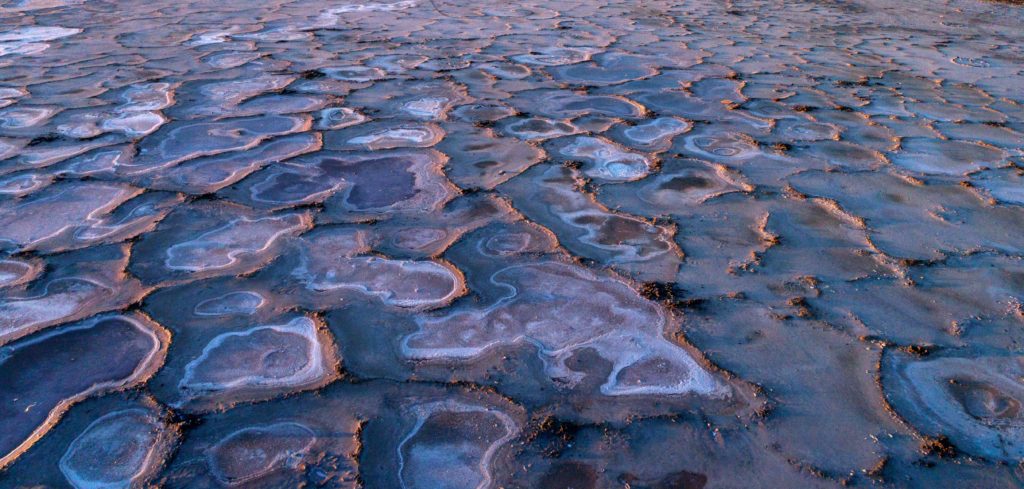
Over the decades, drying lakebeds have accumulated various minerals such as selenium and mercury.
Untangling competing ideologies about natural resources for policymakers and water managers has been a long-time focus for Endter-Wada. Policy ultimately drives the decisions surrounding how much water eventually winds up in the lake. Salvaging the lake’s freshwater inputs requires innovation and cooperation at an unprecedented level. One possible solution is an Extension Water Initiative project Endter-Wada is currently leading that focuses on water banking.
“Getting additional water to the lake through various kinds of exchanges is one of the policy issues we are researching,” she said. Maintaining the integrity of the Great Salt Lake ecosystem into the future requires viewing it holistically, rather than pitting scientists and policy advocates against each other.
‘Some diminished thing’
The ambling Bear River connects farmers, wildlife managers, and communities along its 491-mile journey through three states before flowing into the Bear River Migratory Bird Refuge, the last stop before salinity.
That is where the USU students began their tour of the Great Salt Lake. USU’s professors Karin Kettenring, an expert in wetland restoration, and Trisha Atwood, an expert in aquatic ecology and global change, caught up with them on the upper deck of a wooden tower overlooking the refuge. A taller, steel-framed tower existed prior to the flooding of the refuge in the mid-1980s. Since, the landscape has changed considerably. The salty waters flooded much of the diked areas and killed off large swaths of bird-friendly bulrushes. That opened the way for the fast-growing Phragmites australis to move in and displace the native plants by laying down suffocating stands that have crowded out other wetland vegetation. As a result, it overtook important habitat for shorebird and waterfowl, and with it, fewer places for birds to nest, loaf, and forage. It also greatly reduced human accessibility, including to duck hunters, who contribute some $97 million per year to the state’s economy.
Kettenring has been relentless in her fight to find ways to eradicate, or at least slow the mad march of this giant perennial grass on Utah’s marshes. She handed the students a physical map showing the Bear River winding through parcels of sectioned off property through portions of Box Elder County before ending its journey at the bird refuge. The legend showed federal property in green, private land depicted in blue, and state-owned swaths represented in yellow. The blue dominates, but the green, such as the bird refuge, is also significant. The outlined boundaries of each parcel interlock like pieces to a puzzle.
The single largest parcel of blue on the map is the Bear River Club, which exists for duck hunters who pay thousands in annual fees. It also exists as 14,000-acres of valuable marshland adjoining the bird refuge. Marshland that provides habitat diversity that, in turn, produces intraspecies diversity. Acres of land populated with native cattails, pickleweed, and leafy pondweed that at first glance, look plain and deceptively simple. However, as Atwood points out, some among those cattails are taller, some shorter, some bushy, some not.
“In reality,” she told the students, “Intraspecies diversity is high in wetlands, thousands of different genotypes are out there. … The fact that there is such genetic diversity provides many ecosystem services.”
Connectivity is a theme the students would hear throughout the day. Linkages that are not just for the birds, but for humans and quality of life in the nation’s second driest state. Wetlands and the wildlife they sustain are also sponges and kidneys that absorb and filter a fair amount of water and release that water more slowly. For Utah, the ones surrounding the lake are essential, Kettenring said.
“A very small percentage of Utah is wetlands and a lot of it is riparian strips along rivers and streams and the biggest is along the Great Salt Lake,” she said. “The Great Salt Lake holds 75 percent of Utah’s wetlands. If we lose this, we’ve lost it all, pretty much.”
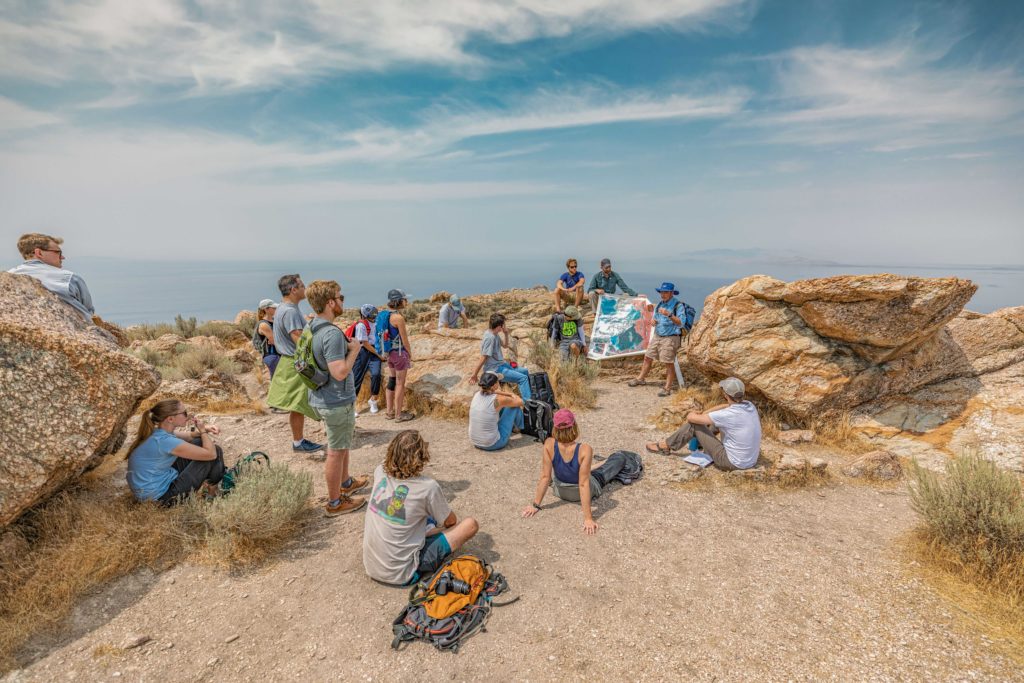
Wayne Wurtsbaugh, watershed sciences professor emeritus, tells graduate students where the lake has been, where it is today, and what lies ahead. Photo by John DeVilbiss.
If we are not at the tipping point, we are at least at a critical juncture. With the lake still hovering near record-low levels during a summer that had not been that hot since 1895, with massive wildfires, and low reservoirs, it is a bellwether, and time is running out, de Freitas said. “We need to think about how we are going to reckon this as we grow with the limited resource of water and still regard our natural resources so we have a quality of life.”
Research is what gives her and Wurtsbaugh hope. The Great Salt Lake is in much better condition than many of the other saline lakes around the world, Wurtsbaugh said later in his office, lined from floor to ceiling on both sides with books and manuscripts.
“We still have time to act,” he said. “We have the financial resources to avoid further degradation, or even to return water inflows to the lake. We now have an extremely motivated conservation community and resource agencies knowledgeable about the issues. Now the lake needs the support of the general public and the political will so we can avoid the fate of other saline lakes of the world.”
What to make of a diminished thing? Robert Frost once asked. It is a question today worthy of the lake’s future. A question, and an opportunity, to re-think how we use water and what can be done to save more of it. It may involve re-writing existing water laws that allow users with water rights upstream to give users downstream portions of their allotments without jeopardizing their historical rights. Perhaps it’s through critical wetland reserves created by private landowners.
Casey Snider, ’11 executive director of the Bear River Land Conservancy, said easement gifts are a model of conservation partnerships similar to the 500-acre Bear River Bottoms that his organization manages with PacifiCorp Energy, the property owner that donated the land easement. “If we can take the land around those critical waters and the water that is maintained or connected to those lands, we’ll be able to ultimately impact what happens downstream,” he said.
None of this will be easy. It will require people and communities to step back and see the system like a puzzle containing many pieces that connect to everyone and everything else. Including municipalities looking to grow, farmers protecting their livelihoods, bird watchers, tourists, duck hunters, and brine shrimp and mineral extraction industries.
“It cannot be a zero-sum game, Snider said. “Because we all have some connection there, everybody has to benefit … you can’t pick a winner and create losers in this because it sets the whole thing off balance and ultimately you’ll impact yourself.”
Laura Ault, MS ’05 who works as a Sovereign Lands Program Manager with the Utah Division of Forestry, Fire and State Lands, says water right allocations are designed with people in mind, not necessarily the lake itself. Its water rights depend upon collective advocacy. The challenge is to get people to see this shared resource beyond the swarms of flies. To appreciate that water ending its journey there also contributes to mountain snowpack through lake-effect evaporation. To understand that the rotten-egg aroma wafting from Farmington Bay is not the lake, but sulfur venting from the shallower oxygen-deprived bays caused by human-fed nutrients. To get out on days and bays where these are not problems.
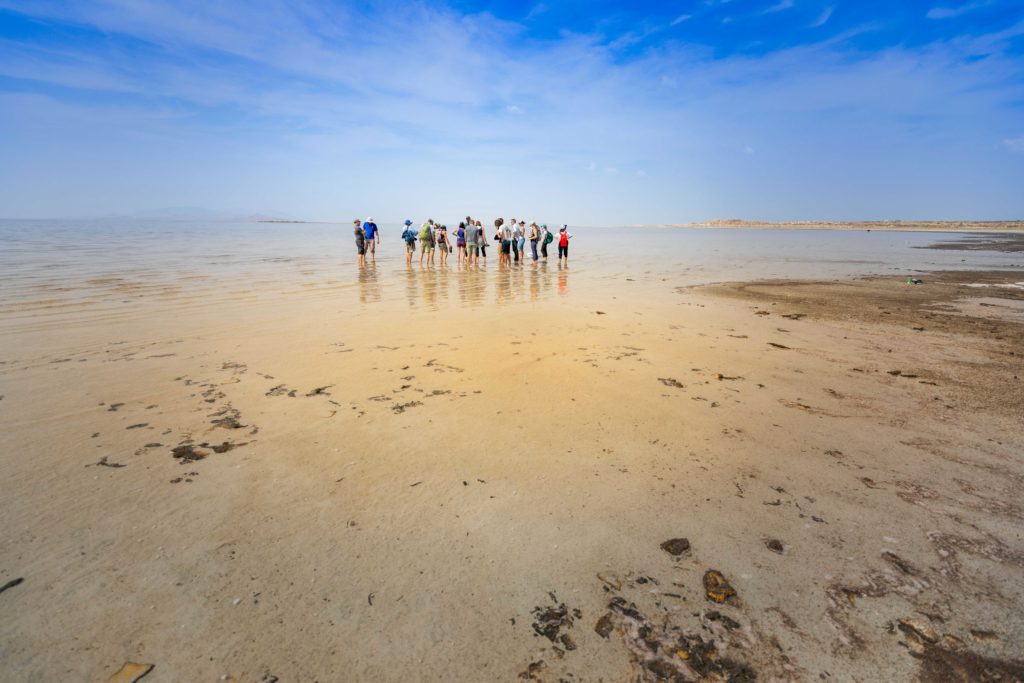
Graduate students tour the Great Salt Lake.
“You know it changes people,” Ault said. “They come to understand its importance. They see its beauty, and they want to learn more about it. It is one of the most unique water bodies in the whole world and we have it right in our front door.”
Even though she has lived in Utah all of her life, it was not until 2003 that she first appreciated the lake. One day she and some fellow USU grads took a side trip to its north end to see Robert Smithson’s Spiral Jetty. Built in 1970, the famous earthwork originally extended 1,500 feet into the briny waters. It was just beginning to re-emerge when Ault took that trip. The classmates cracked their oil pan getting out to it, but the extra time it forced upon them was worth it. Fifteen years later, the Spiral Jetty looms like a giant question mark on the floor of a dry lakebed. It leaves plenty to wonder, Ault said.
“We want to get people out there to tell the story,” she said. “But how do we do that? How do we let people know that it is important? How do we instill a love for something that people have dismissed for so long? How do we get them to care?”
Curiously, the lake is both famous and obscure, wrote Gary Topping in Great Salt Lake: An Anthology published in 2002 by USU Press. “Few visitors to Utah can resist the temptation to stand on its shore, to marvel at the anomaly of a huge lake in the midst of a desert, and perhaps to dip a finger into its brine to verify its high salinity. But native Utahns take the place almost totally for granted.”
Snider agrees. If it was not for annual duck hunting trips taken there since he was 12, the lake probably would not mean as much to him either. “It is easy to miss, because it has always been there,” he said. It is one of the reasons he likes taking people out on his airboat, to give them a chance to see it from a fresh perspective: the tail-end of a highly integrated ecological system that deserves attention.
“Everyone has some skin in the game when it comes to the Great Salt Lake or its tributaries, and so finding a way that everyone can win and benefit is a really unique opportunity,” he said. “You can’t say that because the lake is drying up that we are all doing something wrong. The lake is drying up and that means, to me, that we need to be doing something different.”
Drone Footage of the Spiral Jetty may be seen at the following link: https://utahstatemagazine.usu.edu/environment/spiral-jetty-video/
by John DeVilbiss
Editor’s note: Text in this story has been updated to clarify a date reference to “Sea Monkey” packets.
Robert Smithson
SPIRAL JETTY, 1970
Great Salt Lake, Utah Mud, salt crystals, rocks, water
1500 feet long and 15 feet wide
Collection: DIA Center for the Arts, New York
© 2019 Holt/Smithson Foundation/Licensed by VAGA at Artists Rights Society (ARS), NY
Reproduction, including downloading of—works is prohibited by copyright laws and international conventions without the express written permission of Artists Rights Society (ARS), New York.






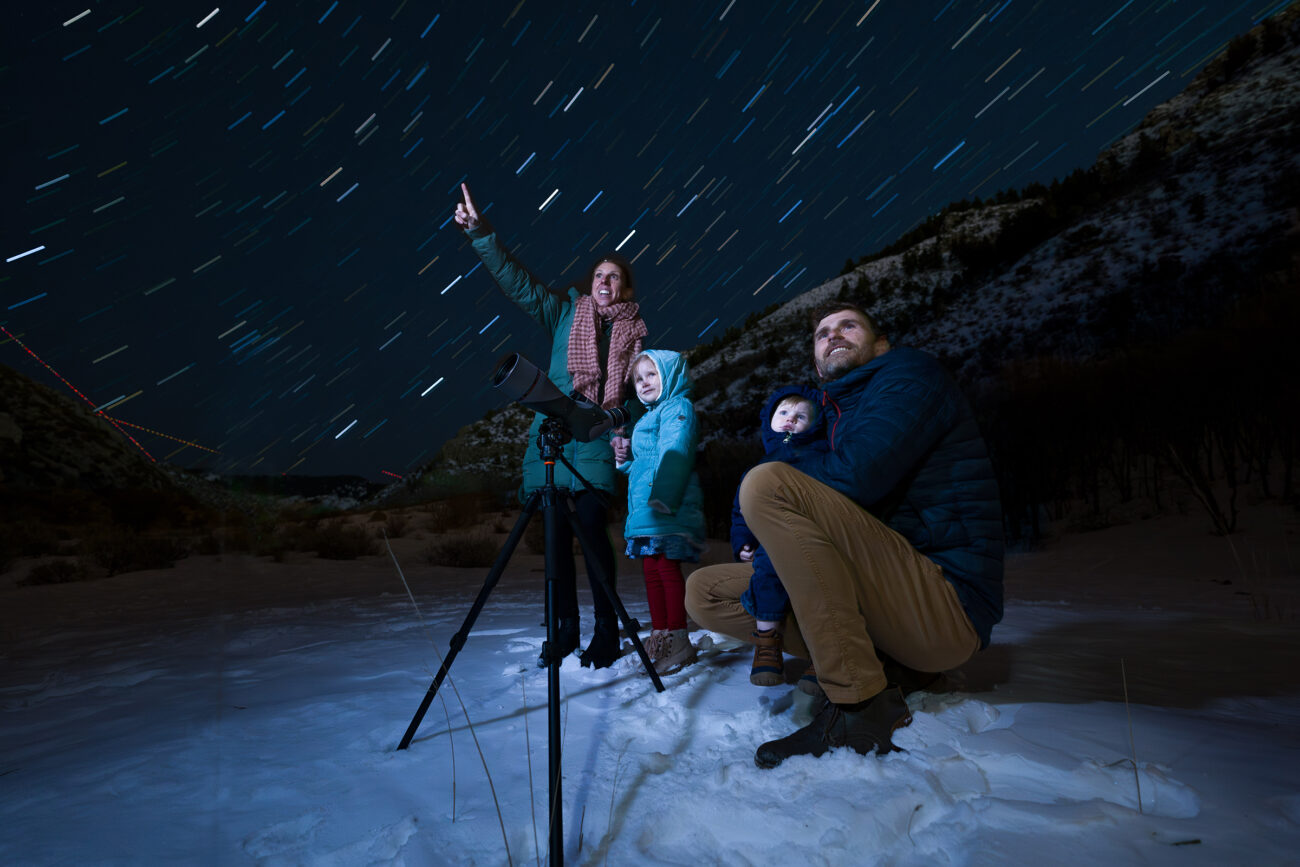
Hilary Shughart February 3, 2019
‘Sea Monkeys’ have been sold since 1962, not 1980 as stated in the article.
“Von Braunhut was granted a patent for this process on July 4, 1972. They were initially called “Instant Life” and sold for $0.49, but von Braunhut changed the name to “Sea-Monkeys” in 1962. The new name was based on the supposed resemblance of the animals’ tails to those of monkeys, and their salt-water habitat.” https://en.wikipedia.org/wiki/Sea-Monkeys
USU Editor February 26, 2019
Editor’s Note: We apologize for incorrectly referencing the early 1980s for when “Sea Monkey” packets began to be sold. Wayne Wurtsbaugh, professor emeritus with the USU Quinney College of Natural Resources Watershed Sciences Department, clarified that when he arrived in Utah in 1983, the brine shrimp cysts from the Great Salt Lake were used primarily for sea monkey novelty kits. “However, I didn’t mean to imply that the early 1980s were the start date for this commerce,” Wurtsbaugh said. “In the mid-1980s, the commercial exploitation of the cysts took off, as their use in aquaculture exploded at about that time.”
Tony January 20, 2019
When I attended Utah State in the early 1980’s the lake was at its highest levels in recent history. Utah spent lots of money to build pumps to lower the lake levels by pumping water out into the desert fearing the lake would eventually overtake Interstate 80 and other developed areas.. While short-term weather patterns over a few years can affect short-term lake levels, I wonder if the ever expanding population in the basin has had a bigger effect on the lake. Water diverted for irrigation has certainly declined as urban areas have overtaken historical farmland in recent years so declines in inflows to the lake must be caused by either a dryer climate or an increase in urban water consumption. It’s very difficult to control either of those two dominating factors.
Keith Johnson January 9, 2019
i agree. where are the Spiral Jetty drone images?
USU Editor January 16, 2019
Keith, the video is now available to view here: https://utahstatemagazine.usu.edu/environment/spiral-jetty-video/
Carl Jirgensen January 8, 2019
Do you know if the mineral content if the dust blowing off the dried portions of the Lake has been analyzed for mercury or other toxics?
USU Editor January 10, 2019
Hi Carl.
The university, through lead-researcher Janice Brahney, is currently in the process of capturing Great Salt Lake dusts and analyzing their content for mercury and other toxins. In the event that early findings indicate a public health risk, Dr. Brahney said she would report that data, otherwise, she expects to release her findings in 2020, at the conclusion of her research. Dr. Wayne Wurtsbaugh reported that we do have information on mercury and other metals in the deeper portions of the lake overlain by water. Here is a link to that report: https://digitalcommons.usu.edu/wats_facpub/556/
Susan January 4, 2019
I wanted to see the drone footage of the Spiral Jetty mentioned at the end of the article – can’t seem to find it.
USU Editor January 10, 2019
Hi Susan,
Thank you for writing about this. You haven’t been able to locate it because the video is not uploaded yet. We hit an unexpected delay with the production and expect the video to be available in about one week on the site. My apologies for the inconvenience!
USU Editor January 16, 2019
Susan, the video is now available to view here: https://utahstatemagazine.usu.edu/environment/spiral-jetty-video/